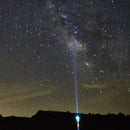Introduction: Motion Blur Photography
We've all seen those glamorous action shots - the snowboarder finishing his jump off a ramp, the cars flying by on a race track, etc. In this Instructable, I'll be giving you some tips and tricks on how to create some interesting photographs of moving objects yourself!
Even better, you don't need a fancy DSLR to take these types of photos. A simple point-and-shoot will work just as well, but if you want more control over your images for better tweaking, go right ahead!
Step 1: General Background
I used a Canon Powershot A4000 to take these photos. Depending on your particular camera, you may have more or less options that you can pick from - in my case, the Program Mode of my camera let me choose only my ISO sensitivity.
What's that, you ask? The ISO setting of cameras dictates how sensitive your camera's sensor is to light. The higher it is, the more sensitive it is, and your camera will "see" more light particles. This is ideal for night-time photography, when there isn't much light to begin with. However, with higher ISO settings, there comes a catch: your photos become more grainy.
Two other important settings for photography are shutter speed and aperture. Your shutter speed is how long your camera's aperture stays open to capture an image. For action shots, ideally you want something very small, in the range of 1/500 of a second or less. (However, this Instructable teaches you to tweak that just a bit!)
Aperture is how big the "hole" of your camera lens opens to control how much light enters. The smaller the number (for example, f2.8 or f3.0), the bigger the hole, and the bigger the number (f22), the smaller the aperture. For dark situations, you want a big aperture to let in more light. Aperture can also be used to control your "depth of field" - how much of your object is in focus. To take pictures of landscapes where you need very distant objects to stay in focus, choose a small aperture (f22, for example). To take close-up images, pick a big aperture.
Let's move on!
Step 2: Prep Your Camera!
To take these types of photos where just your object of interest is in focus, but the background is blurred, some tweaking must be done. A fast shutter speed will cause everything in your photo to be in focus. Therefore, a slower shutter speed is desired. Unfortunately, the Program Mode of this particular camera doesn't let the user choose their own shutter speed or aperture, so I was forced to adjust my ISO. One more useful note about ISO is that a smaller ISO will slow your shutter speed (the shutter is open longer), while a high ISO will increase your shutter speed (the shutter closes faster). I picked ISO 100 to take these photos. The camera auto-selects the rest.
But wait! Won't a slow shutter speed cause everything to be blurry then, since the object is moving? Technically yes, but with a particular trick, you can make it so that only your object is in focus.
The second photo shows my camera poised to take a picture at 1/20 shutter speed and F3.0 aperture, with an ISO of 100.
Alright, let's take that picture!
Step 3: Taking the Photo!
Here's the trick.
Hold your camera steady and find the object that you want to capture. While you're holding your camera, depress your shutter release button halfway to focus on the moving object. Move your camera along at the same speed that the object is moving, and try to keep your object in the same frame as you pan your camera along with the object. It's important to keep your camera level, and avoid abrupt motions. Fully press your shutter button whenever you're ready! The object in reference with your camera will appear to be still, but the background will be moving at a different speed from the camera. Hence, you get a blurred background.
Obviously, this is easier with people since you won't have to pan your camera as quickly - timing your photo with cars was a much more difficult task. Play around with your shutter speed/aperture if you have a camera with a manual mode - practice makes perfect!
Please critique and comment, as this is my first Instructable! If you liked it, please consider voting for me in the Photography Tips and Tricks Contest!
Thanks for reading, and have fun with motion photography!





